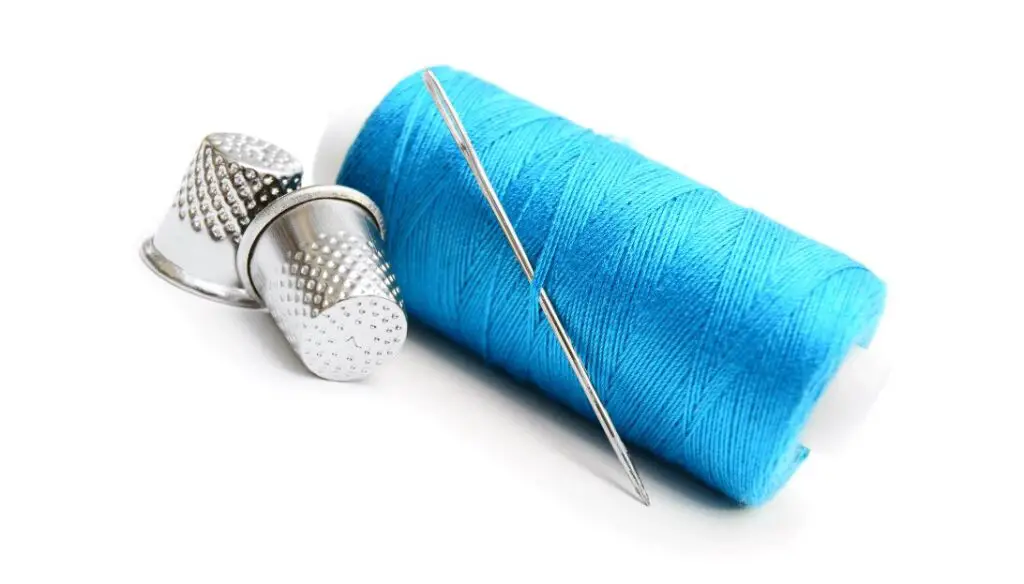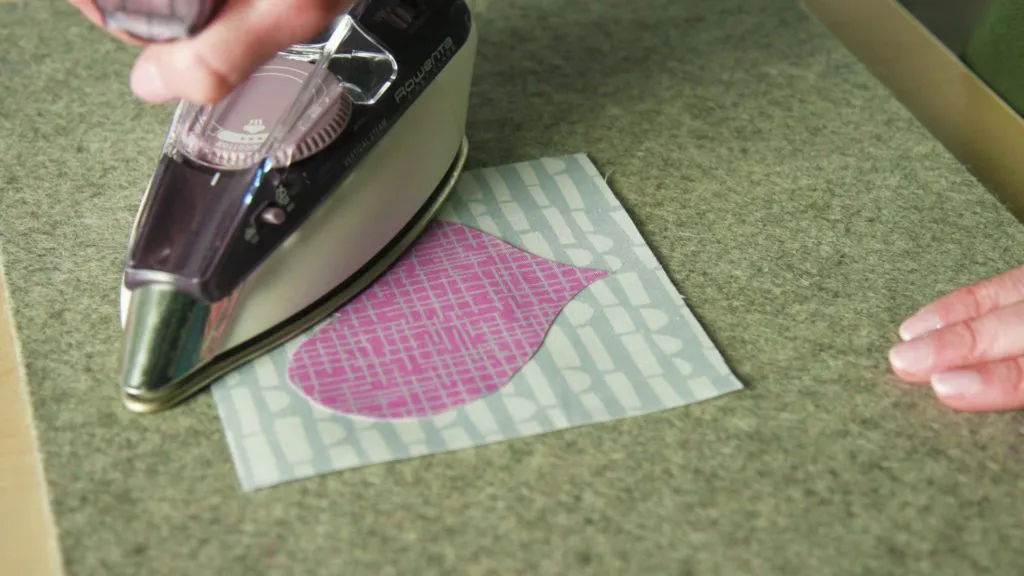Patches are often used to embellish and personalize clothing. You can personalize almost everything: denim jackets, jeans, bags, caps, and much more. It’s a way to add unique designs, logos, or messages to clothing, and create recognizable pieces of clothing.
As for me a reason for patches are holes in kid’s clothes. Iron on patches are a great way to hide little or bigger holes in clothes.
In this article, we are going to show you different ways to sew on a patch.

Contents
- 1 Method 1 – How to sew on a patch with a sewing machine
- 2 Method 2 – How to sew on a patch by hand
- 3 Method 3 – How to fix an iron-on patch to your garment
- 4 How to sew a patch onto a t-shirt using a sewing machine
- 5 How to hand sew a patch on your jean jacket to repair a rip or a hole
- 6 How to sew on patches with a stitched border
- 7 FAQ
- 8 Conclusion
Method 1 – How to sew on a patch with a sewing machine
Equipment:
- Patch
- Needle and thread
- Sewing pins
- Double-sided tape

Steps:
Step 1: Place the patch with the double stick tape to hold your patch in place temporarily while you secure it in place.
Step 2: Turn on your sewing machine. To attach this patch, remove the arm from your sewing machine to make it easier and have more room to work on this project.

Then set your sewing machine to a standard stitch length at 2.5 and start to sew around the patch. Try to be as close to the edge of the patch as possible, so that way that thread doesn’t interfere with the design of your patch.
Step 3: Once you’re done sewing the patch around the perimeter, just make a few reverse stitches to secure, and then take off your project and trim those threads.
Method 2 – How to sew on a patch by hand
Equipment:
- Patch
- Needle and thread
- Thimble
- Double-sided tape

Steps:
Step 1: Thread the needle.
Step 2: Stick the double-sided tape to the back of the patch.
Step 3: Choose the correct place on the garment for the patch.
Step 4: Remove the other side of the tape and stick the patch to the garment. Now you are ready to sew a patch onto your garment.
Step 5: Your very first stitch on your patch is going to come from the back side or the inside of your garment. That way the knot on your thread won’t be visible when you’re wearing it.
Try to keep your stitches as close to the outside and the perimeter of your patch as possible and keep making your way all the way around outlining your patch.
Step 6: Keep your stitches tight together between 1/25 inch-1/16 inch apart. Consistency and patience is the key to a tidy job.

Step 7: Tie a knot in the thread when you’re finished. Flip your garment to the back side and pick up just a few pieces of thread or a small piece of fabric with your needle.
Then, as you pull, it will make a natural little loop where you can leave your needle back through that loop before you pull that stitch tight. This will secure it and keep that patch in place.
Step 8: All you have to do now is just trim your excess threads. Check for movement of the patch. It should be tight, not loose.
Method 3 – How to fix an iron-on patch to your garment
Equipment:
- Fabric and the patch
Steps:
Step 1: Spread the garment on the ironing board, and put the patch in place.
Step 2: Cover the patch with a cloth to protect the garment and the patch. Set the iron to the “synthetics” setting, to prevent damage. Use slowly, about 10-15 seconds in one place, to be sure the glue is well stuck to the fabric.

Step 3: Turn the product inside out.
Step 4: Cover the reverse patch area of the garment with a piece of fabric to protect it. Place the iron over the patch area for about 10-15 seconds, and keep it in one place.
Pay attention to the edges of the patch. They must be well glued all around the edge. If you see the edge is not glued down properly, then reheat the edges again.
How to sew a patch onto a t-shirt using a sewing machine
Equipment:
- Tape measure
- Needle and thread
- Stitch witchery
- Threaded bobbins
- Sewing Pins
- Thimble
- Seam Ripper
- Scissors
- A patch
- Sewing Machine
Steps:
Step 1: Put the tape at the right of the shirt’s neck and place the patch around 3 inches down from the neck. Center the patch in between. Rut a needle through the top of the patch. Make sure the patch is well-centered and at 3 inches.
Step 2: Tear out some stitch witchery and place it behind the patch as it is partly needled down. Get a second needle and pin the bottom on the patch.
Step 3: Turn the t-shirt around. Iron the patch from the inside of the shirt. Make sure it’s hot but not too hot. Press it down for at least 20 seconds. Turn the shirt back around and take off the pins.
Step 4: Use a reliable sewing machine. Place the shirt under the sewing machine’s needle. Turn the shirt 90 degrees to the right so you can sew a patch with ease. Lower the presser foot and allow the needle to pierce through the top of the patch.
Start sewing a patch onto a shirt. Sew in reverse mode so as to lock the stitch. Then continue sewing forward and move the shirt as you do so. When you pass the thread line. Sew in reverse again. Sew forward again. Just a bit. Cut the leftover thread off.
Step 5: Using a seam ripper, clean up the shirt by cutting off loose ends.

How to hand sew a patch on your jean jacket to repair a rip or a hole
Besides embellishing denim jackets with patches, you can also repair holes.

Just follow the steps below:
Step 1: Cut off all the loose threads around the hole. Remove any very badly damaged or very worn fabric on the edges and all of the loose threads. Then turn the jean jacket inside out.
Step 2: Cut out a piece of denim and a piece of fusible web just a little bit longer than what you’re going to need (the larger this denim patch in relation to the size of the hole the stronger it will be).
Lay the fusible web over the hole in the jacket, and then use a pen to draw out the shape you need onto that web. Cut along that line cutting through both the fabric and the web. Now you’ve got a piece of fabric in a piece of the web that is the same size.

Step 3: Trim down a piece of fusible web, because it needs to be a little bit smaller than a piece of fabric. Put the fusible web over the hole in the jacket making sure that the hole is centered. Trace around it, but make sure that you make the tracing one or two millimeters larger than the hole itself. Cut along this line.
Step 4: Then take the jacket, the web, and the fabric over to the ironing board. Add the pieces of fusible web making absolutely sure that they stay outside of the hole in the jacket.
Then on top of that put your patch of fabric, and make sure that there’s no fusible web viewable. Start ironing the fabric patch for seconds, or so until it becomes fused to the jacket.
Step 5: This step is pretty much exactly the same. At this time you’re going to add a patch to the front of the jacket instead. Cut out a rectangle of fusible web and a rectangle of denim.
These pieces should completely cover the hole in the jacket. Attach this denim patch in place the same way. Then apply some fray check around the edge of the patch.
Step 6: Once the patch is secured you need to further secure it using some stitching. To do this, use a very simple running stitch and also a blanket stitch around the edge.
You can pretty much use any sharp hand-sewing needle for this and any strong sewing thread. Cut a piece of thread on one end and feed the other end into the needle and start stitching.
Once you’ve stitched all of the way around to the starting point again then all you have to do is take the needle to the inside of the item and secure the end of the thread.
I hope this article was helpful. I want to thank you all so much for reading. You also could find a lot of useful advice in the article How To Applique Easily With A Sewing Machine.
How to sew on patches with a stitched border
Many patches you can buy have tightly stitched edges, which can be challenging to sew through, particularly by hand. This often leads to sewing either directly over the edges or right next to them.
If you’re sewing by hand, use a whip stitch to sew over the stitched border.

If your sewing machine can reach the patch area on the garment, choose a zig-zag stitch with thread matching the stitched border.
Adjust the zig-zag width (medium stitch length) so the needle lands just outside both sides of the stitching on the patch. Choose a medium stitch length.
Alternatively, you can use a straight stitch on your sewing machine and sew right next to the inner edge of the stitched border.
The thread color can match either the patch’s background or the thread used for the border stitching.
FAQ
How do you sew a patch step by step?
In my article, you can find out three simple ways how to sew patches and choose the one that you like best.
What stitch is used to sew on patches?
For sewing patches or badges, you can use any kind of stitch: running stitch, straight stitch, decorative stitch, blanket stitch, or zig-zag stitch. There are different types of stitches, but the straight stitch and the running stitch are the most common for sewing the patch to the clothes.
What is the best way to sew on a patch?
The best way is to use a straight stitch, you can also use a zig-zag stitch. If you want to keep your fabric from fraying, make sure you use the correct stitch length. The correct length depends on the fabric.
How do you sew a patch on a sleeve with a sewing machine?

The most common placement for a patch on a sleeve is a couple of inches down which makes it still easy to get to with your sewing machine.
Step 1: Take a sewing pin and attach the patch. Make sure everything looks straight, and verify that you’ve got it placed where it needs to be.
Step 2: Now you can start sewing the patch onto a sleeve. If the patch is really thick, increase the length of the stitches to 2.5-3.0 and use a thicker needle, like 90 all-purpose needles. If you don’t want your stitches to show, use a thread of the same color as the edge of the patch. Start to stitch around the patch. When it comes to the sleeve, you usually have to start sewing and stop sewing, so, sew slowly. Every time you stop your needle, have a needle down position. This is a great time to turn a sleeve.
Step 3: When you are finished sewing the patch, make back-stitching for two or three stitches to secure the thread.
Step 4: Raise a presser foot and trim threads.
Conclusion
To sum up, mastering the art of sewing on patches brings both practical advantages and a touch of creativity to your clothing. This article has walked you through the process with easy-to-follow steps, helping you add a personal touch, or give new life to worn-out clothes.
By using these techniques and suggestions, you’ll be able to confidently attach patches, showcasing your unique style and making your garments last longer.
If you like this article please share it with your friends.

Hi everyone and welcome to my blog!
My name is Liz, and I started sewing when my son was born. First I repaired the holes in children’s pants, then I dared to do more challenging projects like sewing home decor and children’s clothing. Now it is my hobby where I come to rest, let my creativity run wild, and create things that please me and enhance my home.
I would love to help other sewing beginners and enthusiasts through my blog by sharing tips and tricks for this great hobby.

